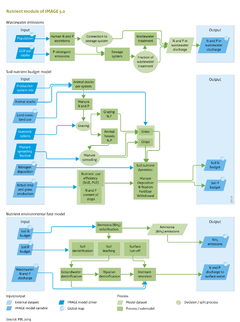Nutrients/Description: Difference between revisions
Jump to navigation
Jump to search
No edit summary |
No edit summary |
||
| Line 42: | Line 42: | ||
Withdrawal of N and P in harvested products is calculated from regional crop production in IMAGE and the N and P content for each crop, which is aggregated to the broad crop categories (wetland rice, leguminous crops, upland crops and energy crops). IMAGE also accounts for uptake by fodder crops. N withdrawal through grass consumption and harvest is assumed to amount to 60% of all N input (manure, fertiliser, deposition, N fixation), excluding NH3 volatilisation. P withdrawal through grazing or grass cutting is calculated as a proportion of 87.5% of fertiliser and manure P input. The rest is assumed to be lost through surface runoff. In calculating spatially nutrient withdrawal, a procedure is used to downscale regional crop production data from IMAGE to country estimates for nutrient withdrawal based on distributions in 2005. | Withdrawal of N and P in harvested products is calculated from regional crop production in IMAGE and the N and P content for each crop, which is aggregated to the broad crop categories (wetland rice, leguminous crops, upland crops and energy crops). IMAGE also accounts for uptake by fodder crops. N withdrawal through grass consumption and harvest is assumed to amount to 60% of all N input (manure, fertiliser, deposition, N fixation), excluding NH3 volatilisation. P withdrawal through grazing or grass cutting is calculated as a proportion of 87.5% of fertiliser and manure P input. The rest is assumed to be lost through surface runoff. In calculating spatially nutrient withdrawal, a procedure is used to downscale regional crop production data from IMAGE to country estimates for nutrient withdrawal based on distributions in 2005. | ||
==C. Nutrient environmental fate== | |||
Nutrient losses from the plant-soil system to the soil-hydrological system are calculated from the nutrient budgets ([[Bouwman et al., 2013]]). For N, the budget is corrected for ammonia volatilisation from grazing animals and from manure spreading ([[Emissions]]). Phosphorus not taken up by plants is generally bound to soil particles, with the only loss pathway being surface runoff. Nitrogen is more mobile and is transported via surface runoff and through soil, groundwater and riparian zones to surface water. | Nutrient losses from the plant-soil system to the soil-hydrological system are calculated from the nutrient budgets ([[Bouwman et al., 2013]]). For N, the budget is corrected for ammonia volatilisation from grazing animals and from manure spreading ([[Emissions]]). Phosphorus not taken up by plants is generally bound to soil particles, with the only loss pathway being surface runoff. Nitrogen is more mobile and is transported via surface runoff and through soil, groundwater and riparian zones to surface water. | ||
| Line 61: | Line 61: | ||
===In-stream nutrient retention=== | ===In-stream nutrient retention=== | ||
The water that enters streams and rivers through surface runoff and discharges from groundwater and riparian zones is routed through stream and river channels, and passes through lakes, wetlands and reservoirs. The nutrient retention in each of these systems is calculated on the basis of the nutrient spiralling ecological concept, which is based on residence time and temperature. | The water that enters streams and rivers through surface runoff and discharges from groundwater and riparian zones is routed through stream and river channels, and passes through lakes, wetlands and reservoirs. The nutrient retention in each of these systems is calculated on the basis of the nutrient spiralling ecological concept, which is based on residence time and temperature. | ||
}} | }} | ||
Revision as of 11:11, 12 February 2014
Parts of Nutrients/Description
| Component is implemented in: |
| Components: |
| Related IMAGE components |
| Projects/Applications |
| Key publications |
| References |
